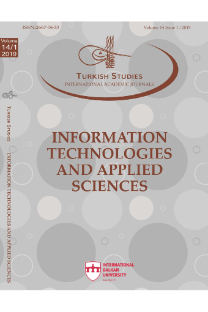TEKNOLOJİNİN OLANAKLARIYLA ÜRETİLEN DİJİTAL RESİM VE ÇİZİMDE DENEYSEL YAKLAŞIMLAR
20. yy. ile birlikte değişen dünya ve teknolojinin gelişimi, özelliklede bilgisayar teknolojisindeki gelişmeler, bir taraftan sanatçıların yenianlatım biçimleri yaratmalarına fırsat tanırken diğer yandan da çeşitliteknolojik olanaklarla daha özgür bir ortamda sanat üretmelerineolanak sağlamaktadır. Teknoloji çağının araç-gereçleri ve beraberindegetirdikleri, zamanla sanatın da araç gereçleri olmaya başlamış vesanatçıları etkilemiştir. Sanatçılar için en büyük çekim alanınıteknolojiyle birlikte bu özgürlük ortamı oluşturmaktadır.Sanatın teknolojik gelişmelerden etkilenmesi, üretim aşamasındasanatçının el becerisinin ötesine geçerek daha düşünsel ve tematik biretkinin teknoloji ile ilişkisinin kurulduğu yeni çağdaş ifade biçimlerininde doğmasına neden olmuştur. Bu çalışmanın amacı dijital sanatın ilkörnekleri olan elektronik sanattan başlayarak, dijital teknolojiyle sanatıbirlikte ortak bir dil ve üretime dönüştüren sanatçıların resmin çizim veboyama özellikleri kapsamındaki deneysel yaklaşımlarıyla ürettiklerigörsel ifade biçimlerini incelemektedir. Özellikle resim, çizim veboyamayla ilgili deneysel çalışmaların dijital teknolojiyle birlikte ortayaçıkardığı yeni olanakları görmeye odaklanmaktadır. Bunun bir nedenielektronik sanatla başlayan ilk örneklerin resim ve çizimi teknolojininolanaklarıyla üretmeyi deneyen çalışmalardan oluşmasıdır. Diğer birnedeni ise sanatçıların sanat üretiminin olanaklarından bir olarakteknolojiyi sanatsal amaçları için bir araç olarak kullanmakistemeleridir. Bu deneysel yaklaşımların geçmişle sınırlı olmadığı, ancakgünümüz sanatçılarının resim ve çizim olanaklarını bugünün yeniteknolojileriyle yeniden yapılandırma deneylerini sürdürdüğü görülüyor.
EXPERIMENTAL APPROACHES IN DIGITAL PAINTING AND DRAWING PRODUCED BY THE POSSIBILITIES OF TECHNOLOGY
The changing world and the development of technology with the twentieth century, especially the developments in computer technology, on the one hand, has allowed artists to create new forms of expression, on the other hand, has allowed them to produce art in a more free platforms with various technological opportunities. The tools of the technology era and their implications became the tools of art in time and influenced the artists. This environment of freedom together with technology forms the greatest attraction area for artists. The influence of art on technological developments led to the emergence of new forms of contemporary expression, which went beyond the artist's dexterity in the production stage and established a more intellectual and thematic effect is associated technology. This study, starting from electronic art, which is the first examples of digital art, examines the visual expression forms produced by the artists who have transformed art into a common language and production together with digital technology, through their experimental approach to drawing and painting. It focuses on seeing the new possibilities that empirical studies particularly in painting, drawing and dyeing have brought together with digital technology. One reason for this is that the first examples that started with electronic art consisted of works that attempted to produce paintings and drawings with the possibilities of technology. Another reason is that artists want to use technology as a tool for their artistic purposes as one of the possibilities of art production. It is seen that these experimental approaches are not limited to the past, but today's artists are continuing their experiments to reconstruct the possibilities of painting and drawing with today's new technologies.
___
- Arslan, Ş. (2006). Fıtrat kavramı çerçevesinde eğitimde insanın ne’liği sorusu. Yayımlanmamış doktora tezi, Marmara Üniversitesi Sosyal Bilimler Enstitüsü, İstanbul.
- Avcı Tuğal, S. (2018). Oluşum Süreci İçinde Dijital Sanat, Hayal Perest Yayınevi: s.118
- Binark, İ. (1979). Bilgi İşlem, Bilgi İşlem Sistemleri, Tarihçe, Bilgisayarlar Ve Ülkemizdeki Durum, Türk Kütüphaneciliği, Cilt 28, Sayı 4
- Bilgen, İ. H. (2019). Yönetim Bilgi Sistemi Tasarımında Stratejik Plana Dayalı Bilgi Katmanları Modeli, Bilişim Teknolojileri Dergisi, Cilt: 12, Sayı: 1, Ocak 2019
- Colson, R. (2007). The Fundamentals of Digital Arts, Ava Academia, Ava Publishing
- Csuri, C. (1998). TACTILE-KINESTHESIS http://www.csurivision.com/index.php/2012/02/tactilekinesthesis/#more-478 Son Erişim: 15.08.2019
- Drain, A. (2007). Laposky’s Lights Make Visual Music, Symmetry Magazine, Vol 4 Issue 3: pp 32-33
- Franke H. (1983). The New Visual Age; The Influence of Computer Graphics on Art and Society, Computer Graphic Forum, Volume2, Issue 2, September 1983: Pages 145-152
- Fröhlich, H. (2017). Vom Rhythmus Zum Algorithmus: Der Digitalkunst-Pionier Manfred Mohr im Interview Apr. 9 - July 2
- Garcia, C. (2016). Harold Cohen and AARON—A 40-Year Collaboration, Aug. 23, 2016, https://www.computerhistory.org/atchm/harold-cohen-and-aaron-a-40-year-collaboration/ Son Erişim: 05.08.2019
- Hendricks, J. (1992-1993). http://www.jochem-hendricks.de/_englisch/w_augen/non_index.htm Son Erişim: 15.08.2019
- Hi, D., (2017). How Artists Connect with Digital versus Physical Painting: The Case of David
- Hockney, January 2017, https://medium.com/digital-art-weekly-by-danae-hi/how-artistsconnect-with-digital-versus-physical-painting-the-case-of-david-hockney-a85b23f1c9a1 Son Erişim: 08.08.2019
- Laposky, B. F. (1960). Oscillons Electronic Abstractions by Ben F. Laposky, A New Approach To Design, Demonstrating Electronic Abstractions An Exciting 20. Century Art Form, Third Annual Exhibition Of Advertising And Editorıal Art, Commerce Building Sioux City 1, Iowa
- Laposky, B. F. (1961). Electronic Abstractions: Mathematics in Design, Recreational Mathematics Magazine, Sayı:4, Ağustos: s.14-17
- Mohr, M. (1960-1998). Manfred Mohr / Monograph, 1960-1998, http://www.emohr.com/ww1_out.html Son Erişim: 05.08.2019
- Nake, F. (2001). Form. Algorithm. Color Manfred Mohr: Algorithmic Man, Exhibition Catalog: Manfred Mohr, "space.color", Museum für Konkrete Kunst, Ingolstadt
- Noll, A. M. (1967). The Digital Computer as a Creative Medium, Bell telephone laboratories, Life Spectrum, October: s.90-91
- Trachtman, P. (1995). Charles Csuri is An 'Old Master' in A New Medium, Smithsonian Magazine, February.
- Tresset P. ve Deussen O. (2014). Artistically Skilled Embodied Agents, Vortrag Gehalten bei: AISB 2014, 1st-4th April 2014, Goldsmiths, University of London, UK
- Verbist, E. (2016). Interview with Patrick Tresset, Artdependence Magazine, 25 August.
- Wands, B. (2006). Dijital Çağın Sanatı, Akbank Kültür Sanat Dizisi, İstanbul
- ISSN: 2667-5633
- Yayın Aralığı: Yılda 4 Sayı
- Başlangıç: 2006
- Yayıncı: ASOS Eğitim Bilişim Danışmanlık Otomasyon Yayıncılık Reklam Sanayi ve Ticaret LTD ŞTİ
Sayıdaki Diğer Makaleler
SEVİNÇ MERT UYANGÖR, Hasan Özkan ÇETİN
CHILD CENTEREDNESS ON THE PUBLIC SECTOR WEBSITES
EĞİTİM BİLİŞİM AĞI (EBA) DERS WEB SİTESİNE İLİŞKİN MATEMATİK ÖĞRETMENLERİNİN GÖRÜŞLERİ
MEHMET NURİ GÖMLEKSİZ, Hacer KOÇ DENİZ
X, Y VE Z KUŞAKLARININ İNTERNETTEN ALIŞVERİŞ YAPMA EĞİLİMLERİNİ BELİRLEMEYE YÖNELİK BİR UYGULAMA
7-9 YAŞ EĞİTİM HEDEFLİ YENİ MEDYA YAZILIMLARININ GÖRSEL TASARIMI VE ÖRNEK BİR İNCELEME: MORPA KAMPÜS
Dilek AYDEMİR, ATA YAKUP KAPTAN
BURSA İLİ KIRSALINDA YAŞAYANLARIN BİLGİSAYAR OYUN ALIŞKANLIKLARI
İsmail Bülent GÜRBÜZ, Özgecan KADAĞAN
TEKNOLOJİNİN OLANAKLARIYLA ÜRETİLEN DİJİTAL RESİM VE ÇİZİMDE DENEYSEL YAKLAŞIMLAR
Necati Barkın AKAY, Gül Çoşkun DEĞİRMEN
